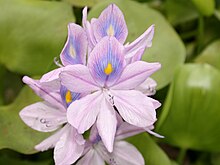Hyacinth, genus Hyacinthus, is a small group of bulbous, spring-blooming perennial plants.

Water garden or aquatic garden, is a term sometimes used for gardens, or parts of gardens, where any type of water feature is a principal or dominant element. The primary focus is on plants, but they will sometimes also house waterfowl, or ornamental fish, in which case it may be called a fish pond. They vary enormously in size and style.
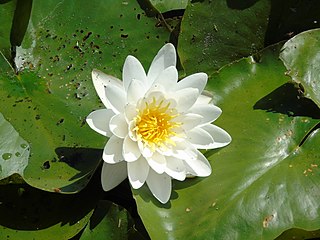
Nymphaea is a genus of hardy and tender aquatic plants in the family Nymphaeaceae. The genus has a cosmopolitan distribution. Many species are cultivated as ornamental plants, and many cultivars have been bred. Some taxa occur as introduced species where they are not native, and some are weeds. Plants of the genus are known commonly as water lilies, or waterlilies in the United Kingdom. The genus name is from the Greek νυμφαία, nymphaia and the Latin nymphaea, which means "water lily" and were inspired by the nymphs of Greek and Latin mythology.

The water caltrop is any of three extant species of the genus Trapa: Trapa natans, Trapa bicornis and the endangered Trapa rossica. It is also known as buffalo nut, bat nut, devil pod, ling nut, mustache nut, singhara nut or water chestnut.
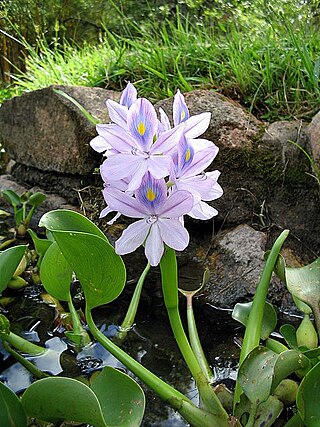
Pontederiaceae is a family of flowering plants.
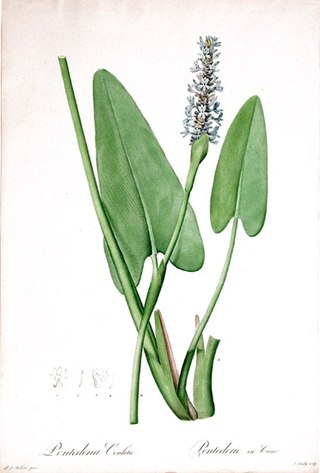
Pontederia is a genus of tristylous aquatic plants, members of which are commonly known as pickerel weeds. Pontederia is endemic to the Americas, distributed from Canada to Argentina, where it is found in shallow water or on mud. The genus was named by Linnaeus in honour of the Italian botanist Giulio Pontedera.

Heterostyly is a unique form of polymorphism and herkogamy in flowers. In a heterostylous species, two or three morphological types of flowers, termed "morphs", exist in the population. On each individual plant, all flowers share the same morph. The flower morphs differ in the lengths of the pistil and stamens, and these traits are not continuous. The morph phenotype is genetically linked to genes responsible for a unique system of self-incompatibility, termed heteromorphic self-incompatibility, that is, the pollen from a flower on one morph cannot fertilize another flower of the same morph.
The mottled water hyacinth weevil, Neochetina eichhorniae, is a beetle that has been introduced as a biological pest control herbivore agent to waterways and lakes in countries worldwide to control the spread of the invasive noxious weed species Eichhornia crassipes, the water hyacinth, an aquatic plant native to the Amazon basin.

Neochetina is a genus of weevils known as water hyacinth weevil which are native to South America.

Pontederia crassipes, commonly known as common water hyacinth, is an aquatic plant native to South America, naturalized throughout the world, and often invasive outside its native range. It is the sole species of the subgenus Oshunae within the genus Pontederia. Anecdotally, it is known as the "terror of Bengal" due to its invasive growth tendencies.
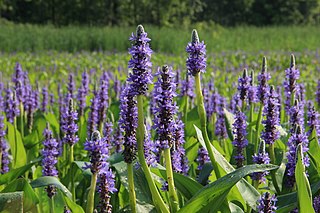
Pontederia cordata, common name pickerelweed (USA) or pickerel weed (UK), is a monocotyledonous aquatic plant native to the Americas. It grows in a variety of wetlands, including pond and lake margins across an extremely large range from eastern Canada south to Argentina. A few examples include northern rivers, the Everglades and Louisiana.

Harike Wetland also known as "Hari-ke-Pattan", with the Harike Lake in the deeper part of it, is the largest wetland in northern India in the border of Tarn Taran Sahib district and Ferozepur district of the Punjab state in India.
Eccritotarsus catarinensis is a species of plant bug from Santa Catarina, Brazil. It is a sap-feeding mirid that removes a considerable amount of chlorophyll from water hyacinth.
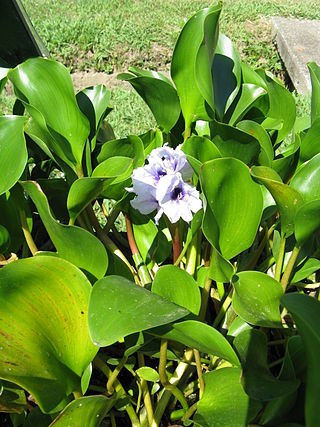
Pontederia azurea is a water hyacinth from the Americas, sometimes known as anchored water hyacinth. It is the type species of Pontederia subg. Eichhornia, which was previously recognized as part of the polyphyletic genus Eichhornia. It is of some interest as an aquarium plant.

Limnobium laevigatum is a floating aquatic plant, and is a member of the family Hydrocharitaceae. Common names include West Indian spongeplant, South American spongeplant and Amazon or smooth frogbit. This plant was introduced to North American waterways through use in aquariums and aquascapes.

Monochoria was originally a genus of aquatic plants in the water hyacinth family, Pontederiaceae. Currently, it has been reduced to a subgenus of Pontederia, Pontederia subg. Monochoria, represented by ten species. Its species are native to tropical and subtropical Africa, Asia, and Oceania. They live in the water or in wet soils. They produce leaves on long petioles and some are cultivated for their attractive flowers. Plants from this species have been utilized in the creation of traditional herbal treatments, food, and cosmetics for a very long time.
Cornops aquaticum is a semiaquatic species of grasshopper native to the Neotropics, from southern Mexico south to central Argentina and Uruguay. It feeds and breeds exclusively on members of the aquatic plant family Pontederiaceae, especially water hyacinth, and is being investigated as a possible biological pest control agent for the water hyacinth in countries where that plant is invasive.

Megamelus scutellaris, the water hyacinth planthopper, is a true bug native to South America. It is used as a biological control agent to manage and reduce the spread of the water hyacinth, an invasive aquatic plant native to South America that has invaded many freshwater systems globally.
